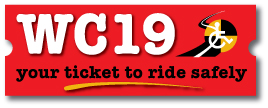An information fact sheet brought to you by…
A project of the Rehabilitation Engineering Research Center on Wheelchair Transportation Safety
Best Practices for Using a Wheelchair
as a Seat in a Motor Vehicle
The following list of do’s and don’ts is intended to guide consumers, care providers, parents, school personnel, and transportation employees about the safest ways to use a wheelchair as a seat in a motor vehicle.
- Whenever possible, only use wheelchairs that are advertised as “transport safe” or “transit wheelchairs” as seats in motor vehicles.
Explanation: Wheelchairs with a “transport safe” label have met rigorous national and international standards and have demonstrated their ability to withstand a crash without major damage. Wheelchairs that do not have the “transport safe” label have not been tested and may cause the user to be severely injured in the event of a crash. - Always secure a wheelchair to the floor of the car, bus, or van in which you are riding.
Explanation: Wheelchairs that are not tied down will slide around inside a moving vehicle. This is unsafe during normal driving conditions, but it is especially a problem in the event of a swerve, sharp turn, sudden stop, or crash. The wheelchair needs to be anchored securely to the floor of the vehicle so that it does not become a large projectile, hurting the user or other passengers - When securing a wheelchair to the floor using a 4-point strap system, be sure that the straps attach to the wheelchair in four locations, two in the front of the wheelchair and two in the rear (using all four straps provided).
Explanation: The four-point tiedown system gives the wheelchair stability in a moving vehicle. This prevents the wheelchair from tilting, tipping or twisting during both normal driving and crashes. - Only attach securement straps to the main frame of the wheelchair.
Explanation: The frame is the strongest part of the wheelchair. While footrest hardware may be the most accessible part of the wheelchair frame, footrests can easily be removed or broken – especially in a crash! Also, avoid attaching securement straps to other removable parts such as armrests or headrests. - Ensure that you are facing towards the front of the vehicle.
Explanation: Research has shown that the forward facing position is the safest. The rider is more stable in this position, and passenger restraint systems are designed for this position. - Insist that you wear the occupant-restraint belt (lap and shoulder belt) provided in the vehicle.
Explanation:Securing the wheelchair is not enough. The wheelchair user must also be protected by shoulder and lap belts, which will keep them safely in their seat. Lap positioning belts and chest straps are not safety restraints, and will NOT protect you in a crash. - Know your rights for wheelchair securement and occupant restraint.
Explanation: Every rider is entitled to a safe ride on any bus. This means that legally every bus must be equipped with a wheelchair tiedown system and an occupant restraint system. Para-transit vans are also being equipped with these devices. The bus or van driver is required by law to offer assistance in securing wheelchairs and helping with occupant restraint systems. No one should settle for unsafe conditions. Advocate for safety! - Insist that the seat belt not loop over the arm rests or cover any devices mounted on the chair, such as an augmentative communication device or lap tray.
Explanation: The seat belt protects the rider only when it fits snug and low across the pelvis. The farther away from the body it is, the less protection it can give. - Even though adjusting occupant restraint belts is difficult, try to find the best belt fit for you.
Explanation: Proper positioning is important! Restraint belts need to fit well in order to provide the most injury protection in crash situations. A lap belt that does not fit low around the hips, for example, may dig in and injure the soft abdominal tissue in a crash situation. A shoulder belt that comes up too high on the neck may cause neck injuries in crash situations, and if it is too low, it may slip off the shoulder and provide no protection at all. - Detachable wheelchair-mounted equipment should be removed for transit.
Explanation: Equipment that is mounted to the wheelchair can come off in a crash situation, causing injury to the user and/or other passengers. It should be removed from the wheelchair and safely anchored in the vehicle. Examples of this type of equipment are lap trays and oxygen tanks.
- You can download this document, "Best Practices", in a PDF format. This will make it easy to print and give to others or use as part of an educational program.
- You will need a free copy of Adobe Reader installed on your computer in order to do this.
Last updated: December 2, 2004




